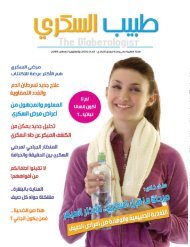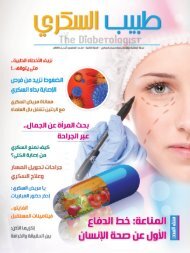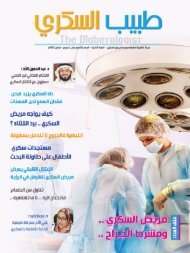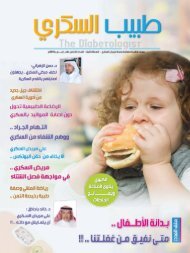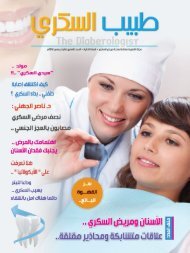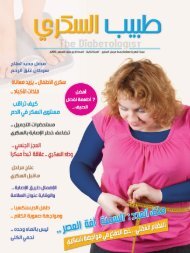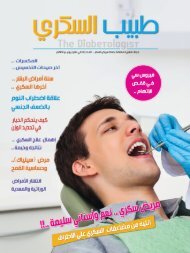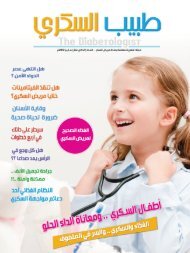The Diabetologist #21
طبيب السكري - العدد 21
طبيب السكري - العدد 21
You also want an ePaper? Increase the reach of your titles
YUMPU automatically turns print PDFs into web optimized ePapers that Google loves.
12 In the absence of unequivocal hyperglycemia,<br />
results should be confirmed by repeat testing of<br />
the initially positive criteria as discordance between<br />
the different diagnostic criteria is not uncommon.<br />
Further, as the ADA/WHO diagnostic<br />
criteria are heavily influenced by the overwhelming<br />
burden of T2D worldwide (>90% of diabetes<br />
cases), clinicians must recall that these criteria<br />
are not T1D-specific and do not always provide<br />
optimal sensitivity for the diagnosis of T1D....<br />
An NGSP method, standardized or traceable to<br />
the DCCT reference assay, for A1C should be<br />
used at diagnosis and for ongoing monitoring.<br />
<strong>The</strong> recent assimilation of A1C as a diagnostic<br />
standard for diabetes exemplifies the challenges<br />
of the diagnostic criteria when evaluating patients.<br />
Because A1C can be performed in the<br />
nonfasting state, has less day-to-day variability,<br />
and does not require stringent patient participation<br />
when measured for diagnostic purposes,<br />
A1C has several desirable qualities of a diagnostic<br />
tool. However, A1C may not provide optimal<br />
sensitivity when evaluating patients with diverse<br />
disease processes culminating in hyperglycemia.<br />
In patients who rapidly develop the disease, A1C<br />
may not rise above current diagnostic criteria despite<br />
marked hyperglycemia. Similarly, in patients<br />
known to be at increased risk for T1D, serial fasting<br />
and OGTT-stimulated glucose concentrations<br />
are likely a more sensitive diagnostic test than<br />
A1C when using a cutoff of 6.5%13. Given the<br />
need to prevent the serious morbidity and mortality<br />
of DKA at diagnosis, ongoing efforts to develop<br />
cost-effective screening or case-finding strategies<br />
in high-risk patients may eventually lead to<br />
diagnostic criteria more specific to T1D.13<br />
Table 1.1 Diagnostic Criteria of Diabetes Fasting<br />
plasma glucose >126 mg/dl (7.0 mmol/L) or 2-h<br />
plasma glucose >200 mg/dl (11 mmol/L) during<br />
OGTT or Clinical symptoms Polyuria, polydipsia,<br />
weight loss, and random plasma glucose >200<br />
mg/dl orHemoglobin A1C >6.5%* *A1C should<br />
be performed using a method that is NGSP-certified<br />
and standardized to the DCCT assay.<br />
DIABETES SUBTYPES<br />
ADA and WHO criteria are used to broadly diagnose<br />
diabetes, however, a combination of immunologic,<br />
genetic, and phenotypic features must<br />
be used to differentiate among the different forms<br />
of diabetes. A brief review of other forms of diabetes<br />
is necessary to frame our ongoing discussion<br />
of T1D. (See chapter 2 for further discussion<br />
of T1D diagnosis.)<br />
T1D has at least two broad subcategories: type<br />
1a diabetes and type 1b diabetes. Type 1a diabetes,<br />
the primary focus of the T1D Sourcebook,<br />
refers to diabetes that is autoimmune in its etiopathogenesis.<br />
Type 1b diabetes results from nonimmune-mediated<br />
β-cell loss (pancreatic agenesis,<br />
pancreatectomy, etc.). In addition to these broad<br />
subtypes, the inherent heterogeneity of T1D has<br />
necessitated additional monikers for patients within<br />
the broad framework of T1D. Some patients, classified<br />
as having fulminant T1D, experience rapid<br />
β-cell destruction; they present with DKA despite<br />
near normal A1C. Conversely, patients labeled as<br />
Latent Autoimmune Diabetes of Adulthood (LADA)<br />
develop T1D over many years, with gradual β-cell<br />
decline that may not be recognized as immunemediated<br />
for years (and sometimes decades) after<br />
the development of hyperglycemia.<br />
Given the growing epidemic of obesity, physicians<br />
must also remember that autoimmune diseases do<br />
not spare those who are overweight or obese. As<br />
such, when an obese patient presents with polyuria,<br />
polydipsia, and hyperglycemia, careful consideration<br />
should be given to making a diagnosis of<br />
T1D versus T2D. A missed or delayed diagnosis<br />
of T1D could result in rapid development of DKA.<br />
Moreover, because patients with T2D can develop<br />
glucose toxicity and a severe enough β-cell deficiency<br />
to cause DKA, clinicians must also be careful<br />
not to label all new-onset patients who present<br />
with DKA as having T1D. Ketonemia and ketonuria<br />
are not typically seen in T2D, but may be present.<br />
<strong>The</strong>y more commonly occur in teens with newonset<br />
T2D than in adults with T2D. Pancreatic islet<br />
autoantibodies are generally absent in T2D but<br />
have been reported in patients with a T2D phenotype.<br />
<strong>The</strong>se cases emphasize the heterogeneity<br />
and crossover of these two distinct diseases.<br />
Some groups have used labels such as double diabetes<br />
or type 1.5 diabetes to describe children with<br />
characteristics of both diseases. Our preference is<br />
to not use such terms. Instead, we consider all patients<br />
with evidence of autoimmunity to have T1D,<br />
while acknowledging the presence of a T2D phenotype<br />
(also thought of as T1D plus the metabolic<br />
syndrome) and emphasizing the importance of<br />
monitoring for and treating associated comorbidities.<br />
In such cases, the presence of autoantibodies<br />
can be helpful. Definitive classification of diabetes<br />
as type 1 or type 2 can be delayed, but treatment<br />
with insulin should always be initiated.<br />
Beyond our focus on T1D we must acknowledge<br />
that T2D accounts for the overwhelming majority<br />
of the world’s diabetes. In the U.S. alone, over 25<br />
02<br />
issue 21 < May 2013






